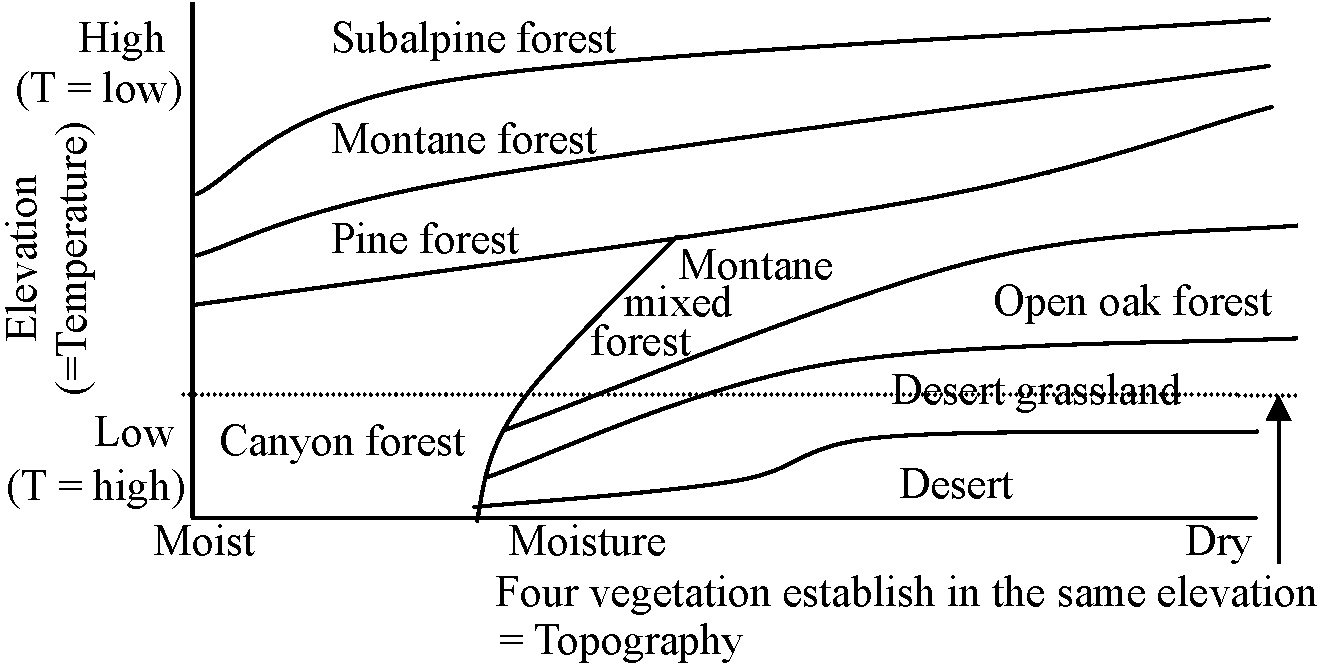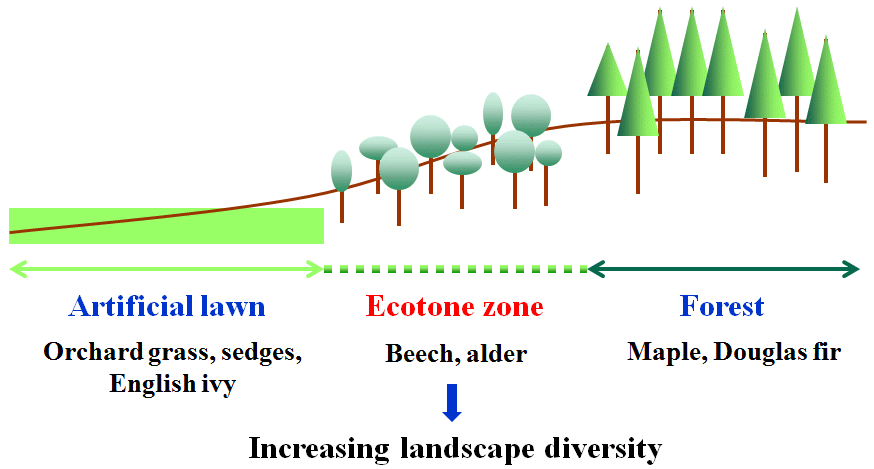(Upload on December 10 2016) [ 日本語 | English ]
Mount Usu / Sarobetsu post-mined peatland
From left: Crater basin in 1986 and 2006. Cottongrass / Daylily
HOME > Lecture catalog / Research summary > Glossary > Ecosystem
[ community | environmnt | ecosystem ]
[ plant community ecology | problems | criteria | ecotone ]
|
Objectives: analyses of pattern and process on plant community
Pattern: spatial, temporal, niche patterns, species along gradients, community in landscape
Uniquity of change in time - patchy dynamics (Ecological) niche (ニッチ)all of the interactions of a species with the other members of its community, including competition, predation, parasitism, and mutualismNiche breadth and overlapNiche breadth (ニッチ幅) = niche width (van Valen & Grant 1970), niche size (Klopfer & MacArthur 1961), versatility (Maguire 1973)the breadth is the "distance through" a niche along some particular line in niche space) Niche overlap (ニッチ重複)
|
The prerequisites for coexistence: = resource limitation, niche and guilds
50 species in New Guinea |
|
Term: proposed by (Humboldt 1805) Plant community (association) is a very global term
The organisms which affect, directly or indirectly, the expected reprocutive success of a reference organism. By a "true" community is meant one whose member individuals interact, either directly or through a chain of other individuals, in a way that effects their individual life times and chances of reproduction and survival. (MacMahon et al. 1981) A group of populations (個体群) of all organisms that coexist in a space and time. The species may interact to each other. Plant communityA plant subset of community; viz. all plants coexist in a space and time. Vegetation (and phytocoenosis)I use as the synonym of 'plant community' in my lecture.
Reference: Phytosociological term |
Coevolution and competition
Coevolution called to tight associations or not ⇔ Competition called to swamp associations or more overlaps ProblemsAre plant communities real or artifact? Real: sample, stand, plot, quadrat, etc. ⇔ Artifact: associations, community types - phytosociology
|
Physiognomy (相観)is 'the form and structure of vegetation in natural communities'.
Examples: Forest, shrubland (bushland), grassland, desert Physiognomy is one of the keys to determine the types of communities, ecosystems and biomes. |
A few examples of physiognomy
|
[vertical distribution of vegetation]
Mosaic Distribution (モザイク分布)Mosaic vegetation diagram Mosaic vegetation change Association = overstory/understory
Crown(overstory) - slow/gradual → Understory - fast/quick |
Def. Ecotone (エコトーン) A transitional area between two adjacent (plant) communitites (s.l.) Transition zone between two major ecological communities where one does not merge gradually into the other, for example that between grassland and woodland. Such steep gradients between communities are often man-made (see 'skislope') (s.s.) The development of ecotone is tightly connected with the environmental gradient.  Artificial lawn Ecotone zone Forest Orcard grass, sedges, Beech, alder Maple, Douglas fir English ivy 🡇 Increasing landscape diversity Case Western Washington |
Ecology (生態学)
|
Environmental science
Action, reaction and coactionAction: environments → organismsReaction: organisms → environments Coaction: organisms ↔ organisms  succession (遷移) explaiend by spatio-temporal changes in environments |
[ system | ecosystem | environment | ecosystem services ]
= ecosystem, biosystem, or ecological systemSystemregularly interacting and interdependent components forming a unified whole. The individual organism cannot survive for long without its population any more than the organ would be able to survive for long as a self-perpetuating unit without its organism.EcosystemAn ecological system that incluedes all the organisms and their environment within which they occur naturally.
+ Plant community Ecological systemUsed for environmental problems → general systems containing ecological characteristics
Characteristics |
(Theodore 1976) Characteristics of ecosystems
If you think protecting species is hard, just wait until we try to protect whole ecosystems. (Noss 1996)
Quiz
Metacommunity (メタ群集)a set of interacting communities which are linked by the dispersal of multiple, potentially interacting species → patch dynamics, species sorting, source–sink dynamics (or mass effect) and neutral model |
Unchangeable modelThis model can be applied with some restrictions, e.g., no consideration of temporal changesEx. population unit: age structure (structure survyed at a given time = disequilibriumo of age structure Changeable model= dynamic midel (system dynamics)Dynamics: the ways in which characteristic structural elements are first developed and subsequently maintained in the various levels of ecological organization. an ecological system that includes all the organisms and their environment within which they occur |
Steady-state open system (定常開放系)Ex. Structure of capitalism (都市化の構造)
┌──────────────┐
│ Capitalism │ ↑
│┌────────────┐│ ↑
││Advanced nations ││ Exploitation
││(eg, Europe, Japan, USA)││ ↑
││ [Capitalist] ││ ↑
││ [Laborer] ││ ↑
│└────────────┘│ ↑
│┌────────────┐│ ↑
││The third world ││ ↑
│└────────────┘│ ↑
└──────────────┘
Landscapee model (景観モデル)Landscapee simulation model (森林景観シュミレーションモデル)LANDIS-II: landscape change model (景観変化モデル), forecasting landscape change due to natural and human causes |